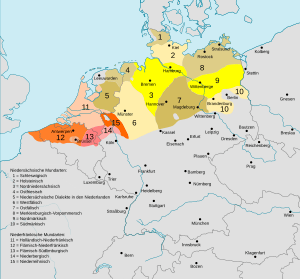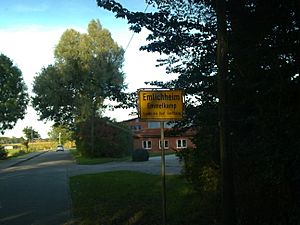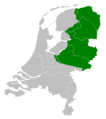Low Saxon facts for kids
Plattdüütsch is a language that comes from the Germanic family of languages. You might also hear it called Low Saxon or Low German. In Germany, it's often known as Plattdeutsch.
Many people speak Plattdüütsch in northern Germany. In the past, this language was spoken in a much larger area. This included parts of northern Poland, the Netherlands, Belgium, and even a bit of France. After World War II, the number of people speaking Plattdüütsch became smaller. Now, it is mainly protected in Germany and the Netherlands.
About 3 to 10 million people know some Plattdüütsch. However, many of them only understand it a little. Around 3 million people can speak it very well. These people are often native speakers, meaning they learned it as their first language.
Contents
What is the Official Status of Plattdüütsch?
The European Charter for Regional or Minority Languages helps protect Plattdüütsch. This important document gives it official recognition as a regional language. This protection is mainly in Germany and the Netherlands.
In Germany, Plattdüütsch is protected in several states. These include Bremen, Hamburg, Mecklenburg-Western Pomerania, Lower Saxony, and Schleswig-Holstein. It also has some protection in Brandenburg, North Rhine-Westphalia, and Saxony-Anhalt. In the Netherlands, it also has official protection.
Some people used to think Plattdüütsch was just a dialect of German. But the European Charter only protects languages, not just dialects. So, the German government agrees that Plattdüütsch is its own language.
Where is Plattdüütsch Spoken Outside Europe?
Plattdüütsch is not only spoken in northern Europe. Several groups of people use it in other parts of the world.
Many Mennonite communities speak their own version of the language, called Plautdietsch. You can find these communities in many places. This includes Russia, Ukraine, Central Asia, South Africa, Malaysia, Indonesia, and Australia. They also live in North and South America. For example, in Mennonite towns in Paraguay or Chihuahua, Mexico, Plautdietsch is often used alongside the country's main language, Spanish.
In the Midwestern United States, some communities used to speak their own forms of Low German. These dialects came from the languages spoken in Schleswig-Holstein and Lower Saxony in the 1800s. It's not clear how many people still speak Low German in the United States today. The language might have mostly disappeared by the mid-1900s. Many German-American groups started using English more. They slowly lost some of their old traditions, including speaking Low German.
Images for kids
See also
 In Spanish: Bajo sajón para niños
In Spanish: Bajo sajón para niños




